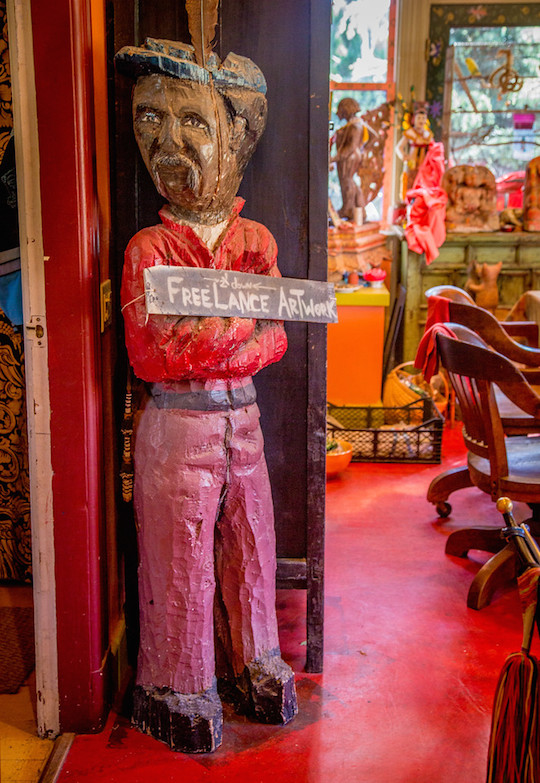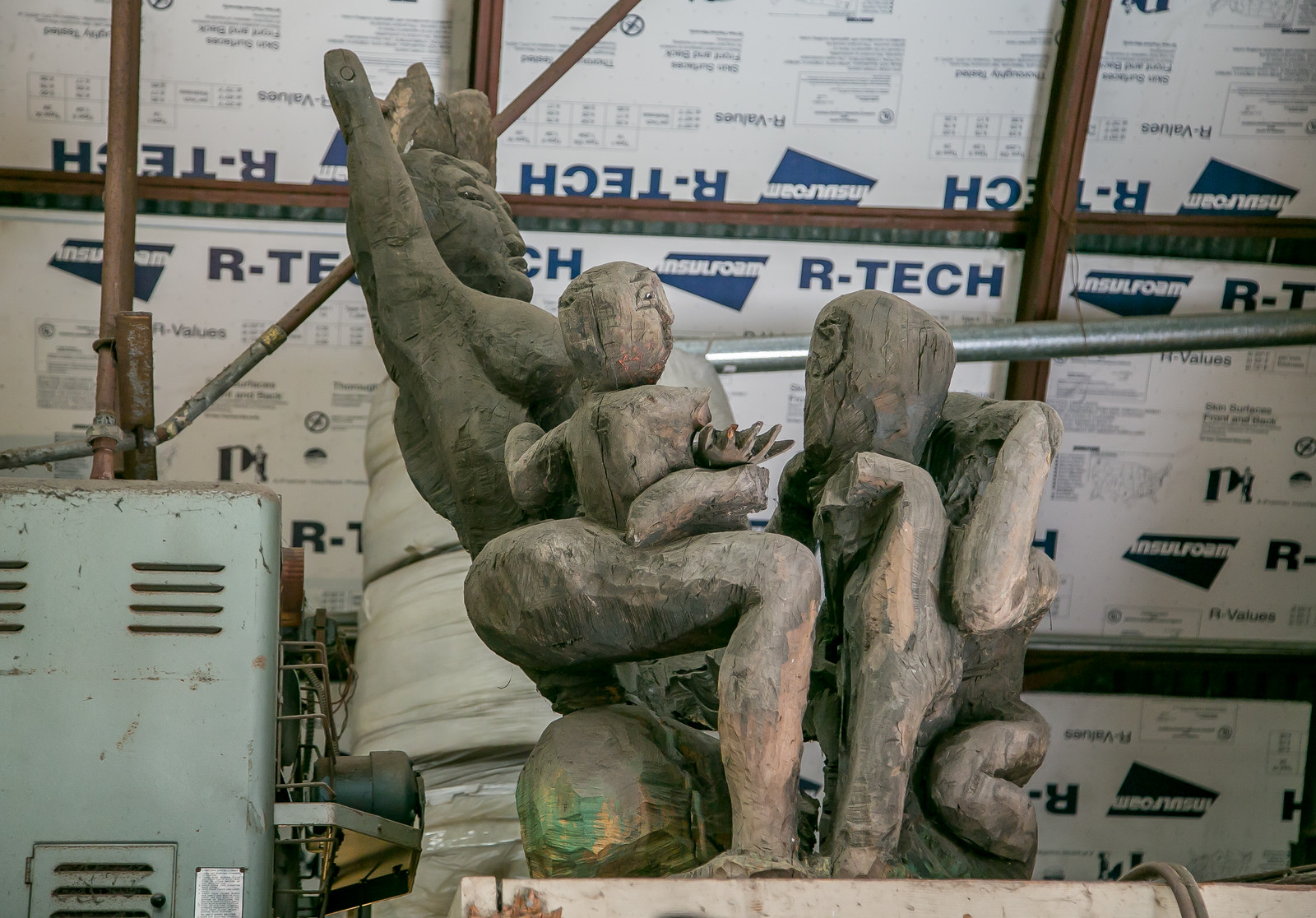Our Martin Luther King Jr. holiday field trip is to west Oakland. It is a thinly veiled salute to the art of the late John Abduljaami.
Abduljaami was born in Shawnee, Oklahoma, in 1941. He quit high school and did a hitch in the Navy, working as a jet mechanic. After the Navy he moved with his family to San Francisco. During a four-year bit in prison for robbery, he found the Nation of Islam and converted to an ecumenical brand of the faith..
After Abduljaami was released, he went to work shoveling grain on a ship in Louisiana. One day, he was nearly buried alive by grain. That was the same day that he decided he was never going to work again.
He became an autodidact wood sculptor. He worked with redwood, eucalyptus, or black walnut, using axe, adze, chisel and chainsaw. He painted his pieces with house paint. Most of his pieces are depictions of people and animals.
We – you and I, not plurals maiestatis (majestic plural, the use of a plural pronoun or corresponding plural-inflected verb forms to refer to a single person holding a high office) and not the editorial plural (Mark Twain is said to have said “Only kings, presidents, editors, and people with tapeworms have the right to use the editorial ‘we'” – but there is no record of him actually having said it), have seen Abduljaami’s work in earlier posts.
At Marcia Donahue’s:
We saw single pieces at the homes of Jana Olson in Berkeley (top) and Susan Alexander in Glen Ellen (bottom):
There are many Abduljaami pieces in the home/workshop/studio of Mark Bulwinkle, some of which I have shown before and some of which I show for the first time here.
And now, finally, we arrive at our holiday field trip destination, 2500 Kirkham Street, Oakland.
Architect Paul Diriscoe, owns the land under our feet at our destination. It is multiple square blocks, very industrial. Here Driscoe has his architectural practice and Joinery Structures, since 1988 a design-build studio and mill specializing in custom projects that integrate sustainable wood practices, innovative design, and precision craftsmanship.
From the Joinery Structures website we learn: “Founder and principal, Paul Discoe, is a renowned Japanese master builder and Zen Buddhist teacher. Paul studied architecture as a Buddhist temple builder in Kyoto, Japan for five years during the 1970s. Upon returning to the United States, Paul founded Joinery Structures to continue pursuing his passion for Asian architecture. By personally training his team in Japanese techniques and representing the architectural process as an embodiment of Zen practice, Paul has helped introduce Asian architecture to the Western world.”
Driscoe was a long-time benefactor of Abduljaami, who worked here for years. Driscoe watched out for him and his work after Abduljaami stopped working.
You enter on Magnolia Street. The sign references O2 Artisans Aggregate, an eco-industrial park that is home to a network of artisans working collectively to develop and promote environmentally progressive projects.
Tucked in a corner is a cage full of Abduljaami sculpture. Starting with those depicting humans:
The final human-depicting piece shows the metamorphosis of Cassius Clay to Muhammed Ali.
To remind/refresh/explain: In 1964, Cassius Clay changed his name to Mohammad Ali, dubbing Cassius Clay as “my slave name”.
Ali fought Ernie Terrell on February 6,1977. On December 28, 1966, the two fighters were in New York promoting the fight. Terrell continued to refer to Ali as Cassius Clay. As the men trash-talked, Ali asked Terrell “Why do you call me Clay? You know my right name is Muhammad Ali.” Terrell answered: “I met you as Cassius Clay. I’ll leave you as Cassius Clay.” Ali called Terrell an Uncle Tom and the shit got real.
Skysports describes the actual fight as a “cruel, callous annihilation” with Ali taunting Terrell, shouting at him “What’s my name?”
His name was Muhammed Ali.
Abduljaami sculpted animals as well:
Out on Magnolia is a hippo:
A little bit down Magnolia is the space that was Fuse Box, a trendyKorean restaurant that has closed. In its courtyard is an Abduljaami piece:
 And just in case you haven’t seen enough photos of Abduljaami’s work, there more on his Facebook page.
And just in case you haven’t seen enough photos of Abduljaami’s work, there more on his Facebook page.
I tried to track down Abduljaami several times in the last few years. I am now too late. His daughter Doris Freeman posted on Facebook on May 9, 2017, a notice of “Uncle John’s Going Home Celebration” on May 17th in Richmond and his burial on May 18th.
I’ve heard many stories about Abduljaami, mostly from Mark Bulwinkle. I mourn his death. I celebrate his life and work.
I showed the draft of this post to my friend.
When he got to the Ali-Terrell fight, my friend got up and did a shockingly good rendition of the Ali Shuffle.
Who knew? I surely didn’t.
After he finished with the shuffle he riffed on Magnolia – the street where O2AA lives. “First association for magnolia?” he asked me.
“Freshman year at Penn, living in 229 Coxe Hall. There was a magnolia outside my window. When it bloomed I knew that I had survived winter, a winter of discontent, personal and political – the horror of Vietnam.”
He wasn’t done. “Best magnolia song? For me it’s ‘Sugar Magnolia‘ by the Grateful Dead. It really rocked me hard in the Seventies and still does.”
I acknowledge the greatness of “Sugar Magnolia” but it’s not that easy. “Not so fast my friend. I suggest that we listen to ‘Magnolia Wind‘ by Guy Clark before we vote.”
He went to his quarters and in a minute came back with a few postcards that he handed me. “From my road years” was his explanation.
He then said “I wouldn’t trade a tree for the way I feel about you.” I then and there knew that we would sit down and have us a Guy Clark evening.
I said, “I’ll make the tea, but first I need to know your take on this field trip post?”



















































Pingback: Quirky Berkeley | Latest Postings